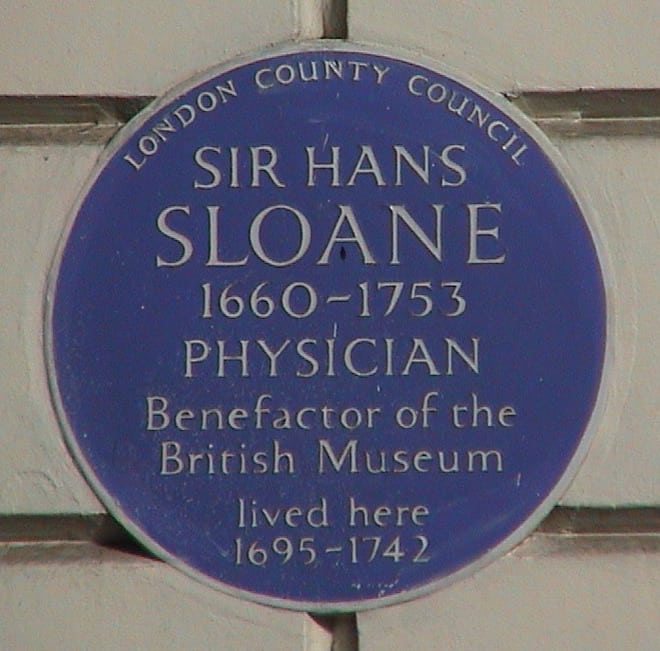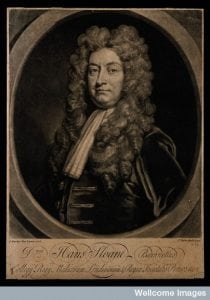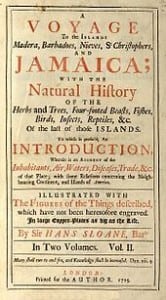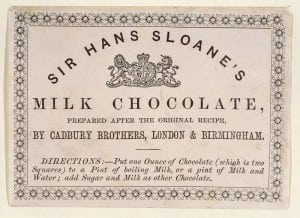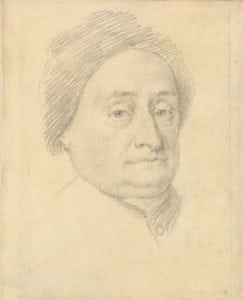Henry Barham Sr. to Hans Sloane – December 11, 1717
Item info
Date: December 11, 1717 Author: Henry Barham Sr. Recipient: Hans SloaneLibrary: British Library, London Manuscript: Sloane MS 4045 Folio: ff. 77-79
-
Language
English
-
Library
British Library, London
-
Categories
Curiosity Reports, Medical, Scientific, Social, Trade or Commodities, Travel
-
Subjects
Botany, Geology, Herbals, Jamaica, Mining, Natural History, Race, Slavery, Worms
-
Date (as written)
December 11, 1717
-
Standardised date
-
Origin (as written)
London
-
Others mentioned
-
Patients mentioned
Henry Hiller
Original Page

Transcription
[fol. 77] Worthy Sr In my last I gave you some [word missing] of the Oars of Jamaica wch that Island Superabounds with and to give a Perticular account of every sort would make a large Treatise of its self at 16 mile Walk in one Palmers Grouns is found Upon the Earth Loose Stones (that seems to Rowl down from A mountain Near the Place) Iron Stones so Rich of that Mettall as seem to be all Iron and very Hard to Brake a Sunder, the Hammer makes an Impression as if Malabell before it would [text blurred] in peeces; and when Parted a Sunder the Inside Lookt as Red as Lapis Hematites I saw A Sharp Corroded Stone Seem to be Broke off from a large Stone of the Same Colour above Mentioned and brought from the Same Place that would Attrack Iron or Steel as Strong as any Magnett in Proportion to its Bigness: it is Certain that there is many Mines in Jamaica as Rich: if there were a Sett of Rich and Publick Spirited Men would Sett Heartily about the Work and with good Resolution to see the Depth or Bottom of them (and I Could Direct them where to begin) But to proceed to the Intended Matter you mention Introduction page 17 of Anti Neasts brought from the Woods in wch are found Clay Balls of Strange Different Shapes as if made by the Art of Man: and in those Wood Wnti Neasts the Amphosbona found I have seen them about 5 or 6 Inches with Perfect Heads at each End Running Swiftly either Direct or Retrogate or to the Right and Left with Equal Swiftness without Turning about: and in Digging Up of Old foundations I have seen those sort of A Worm like Shape Described and figured in Pisol wch when the Negros saw them, would flye from them [as] if Death its self was there saying they have them in their Country and are Present Death to any that are bitt or stung by them. Introd: page: 54- you Mention the Negroes Remedy: of Clay and Water Plaistering over their bodys with it its True some Negroes may use Barly or no other thing than Clay and Water: and I Thought soo for some years that they had used no Other thing: but upon a more Strickt Inquiery I found it was a yellowish Root wch they Call Altoo the Same Root you Mention in your Catalogus Plantarum page 214 viz Radix Firuticosa: glycyrrhia Similis cortica fuses[.] Besides Cleaning their Teeth with this Root they take it and Grind it very fine between two stones with Water and make an Islutamentum with wch they illuse or Plaister them selves with it and When Dry looks like A yellow Earth: Sometimes they only Illutate the Head and Face, if thats effected Sometimes their Stomach if their Heart is effected for they attribute all inward ails or illness to the Heart Saying their Heart is Noo Boon not Knowing the situation of the Stomach from that of the Heart: if their Limbs and Solid parts are effected they Illutate them selves all over saying their Skin Hurts them: The Affricans hath such Confidence and Opinion of this Root outwardly Applied or Inwardly given Decocted they wholly Dispair of any Relief believing it to be the most Soveraigne Remedy that they know Amongst all the Plants that comes Within their Knowledge. This Root was Much used by an Honrbl: Coll: in Ligano and Cryed Up to be one of the Greatest Remedies in ye World in Colicks or Belly aches: He Telling me the many Experiments He had made by A Simple Decoction of this Root: I had a fair Opportunity to Try Wither this Root was of such efficacy and Matter of Fact in a following Case: I Sent A Servant of Mine A Carpenter Up in to the Mountains to fall and Square Some Timber: who [fol. 78] who was takeing Such Care of Him Self when [word blurred] as He Should Soon found the effect of His Neglect Getting A Great Cold and was seized with most violent Pains in His Viscera and in 24 Hours was Thrown into Strong Convulsions: A messenger bringing this Information: I Rid Up to Him: it being A Place of Great Distance from a Town and where Compound me decides was not to be had: I Thought of the Poll: Root wch Grows in Great Plenty within, 3 or 4 Miles of this Place wch I Sent for and Decocted it in Spring Water and Gave this Poor Man (who had had Several Strong Convulsions and in Violent Pains) of this Decoction Warm about half a pint at A time Repeating it very often. the effect it had it first eased Him of His Pains in A Short time after it wrot [?] Gentrly Downwards and in 3 or 4 Days He thought Him Self as Well as ever He was and is easy all His Convulsive Tremors and Symptoms Left Him: His Appetite Returned and was Throughy Recoverd and So Continued without being Nerviated Paralyzed or Conculsed afterwards. In the Same Page it is Certain as you mention the Negroes make use of Fingrigo Roots for Claps and Some of them ad ye Roots of Prickly yellow Wood and Lime Tree Roots: but the most knowing or skillfull Negroes such as they Call (Oba men) or their Country Doctors use yellow Nickers Beaten to A Powder wch they Say Purges and Bindes them after it: like to our Myrabolins. But a Certain Negro Discovered to a Patient of Myne (that had Labourd under an Old Gleet wch Could not be stopt (after due Purging) by no Restringent or Natural Balsams whatsoever) A Plant wch I Shall Mention Hereafter that only by Decocting it and Drinking about half A pint of itt for 3 or 4 Mornings made Him perfectly Well and Sound of His Gleet as He affirmed to me with Reflections that Negroes Could doo more with their Herbs than Wee Practitioners with all our Art or Skill and I had Reason to Believe Him in this Particular Case: because I gave it my Self afterwards with good Success in the Like Case: Introd: page 55 you say one of the Greatest Remedies the Planters living here have to Prevent Diseases or ill effects of What they Call ill Fumes or Vapours is their Contrayerva wch you Call (and not Without Reason) A ristolochia Scandons Odo [?] ratissima: floris labello purpureo Semino cordato et Odoratissima and is Hernandez Tomahuetlopath. [?] and one of His Ingredients in His Grand Elixir or Great Antidoteas I have been Informed by the Spaaniards: and Besides that Remarkable [ink blot] (you mention Performed by an Indian Upon Dr Smallwood when Wounded by a Poison Arrow it hath been found Since by Daily Experiments to be one of the Greatest Antidotes and Antifribriticis inward by Given that is yet or every was Discovered and Besides the Work Hernandez ascribes to it Mentioned in your Natural History of Jamaica page 162 and that of H:M: it Drives out the Small Pox and Measles and is Prevalent in Calentures and Hectick Fevers This is to its Vertues in Generall: in Particular I know one Mr Henry Hill: or a Lusty Fatt Jolly Man When in Health He happened to be seized with the Belly ach wch what with its Violence and Missing of the Expected Help by Remedies He was Reduced to A miserable State and Condition Given over by all that Set Him being emaciated Lost the use of His Limbs Lingring and Walking about with Help like a Disconsolate and Dispairing Man: at Last He was advised to make use of Contrayerva Infused or Decocted in Spring Water and Drink About half A Pint every Morning for some Week wch Recoverd Him as He Told mee Himself: I being one Day in His Company And to all Appearance Seem to be as fatt and as Jolly as ever I Saw him: and Knowing in what Condition I had Seen Him before askt Him how and by what means He was soo Straingly Recoverd: He Told me it was Purely own to the Great Vertues in Contrayerva [fol. 79] Contrayerva for after He had Tried all things as He Called it and took every bodys advice to Noo effect He took to Drinking of an Infusion of Contrayerva every morning for some time: He said it first Brought a Way Gently for some days very Black Stools: afterwards it wrought strongly by Urine and Sweat Creating a very Great Appetite and Restored Him to A Miracle: it is unspeakable the Praise and Character He Gave the Plant it is Now become in Great use in Jamaica for Loss of Appetites Scraped and infused in Wine or A Tea Made off it; if the Vertues of it was as Well Known in Europe as it is in America There would not be A Drugg in Shopes would be of more Demand than this: I saw A Tymponite Girl Cured with the Contrayerva infused or steept in Spring Water with Rusty Iron put with it: I know one Mr Legott that was subject to A Void Much Blood after wch A Great Swelling and Hardness of His Belly followed that I have been Surprised to See Him He Tould me He Valued not His Swelling for I can Take that Away as I Please with Contrayerva the effect I saw and was Matter of Fact it is Experienced to Kill Worms. I hope you excuse me for being so long Upon this Subject: and am Sr. your most Humble and Obliged Servant Henry Barham London December 11th 1717
Henry Barham (1670?-1726) was a botanist. He lived in Jamaica and corresponded with Sloane on the plant and animal life of the island. Parts of Barham’s letters to Sloane appeared in the latter’s Natural History of Jamaica (T. F. Henderson, Barham, Henry (1670?1726), rev. Anita McConnell, Oxford Dictionary of National Biography, Oxford University Press, 2004 [http://www.oxforddnb.com/view/article/1374, accessed 13 June 2011]).
Patient Details
-
Patient info
Name: N/A Henry Hiller
Gender:
Age: -
Description
Man had a cold and suffered from stomach pains that led to 'strong Convulsions'.
-
Diagnosis
-
Treatment
Previous Treatment:
He was given 'Contrayerva' with spring water.
Ongoing Treatment:
Response:'3 or 4 Days' after taking the initial dose the man was in good health, suffered no further convulsions, and a had full proper appetite.
-
More information
-
Medical problem reference
Pain, Stomach, Sleeplessness, Stomach


